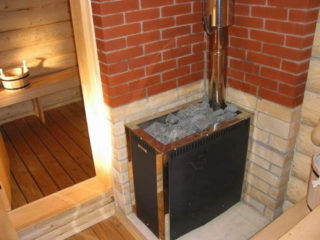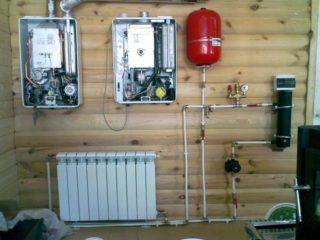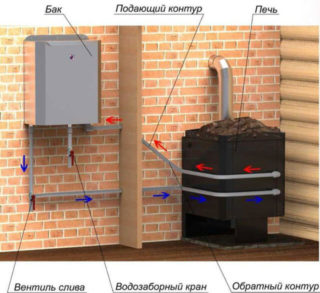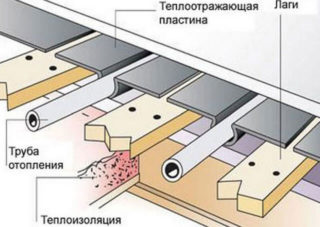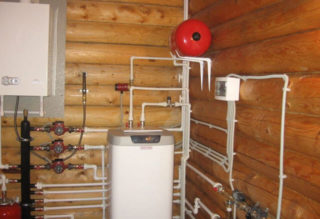To maintain the optimal temperature in the main rooms of the bath, as well as to provide households with hot water, it is important to properly organize the heating system. There are a large number of varieties, some of which the bath owner can sell on his own, without resorting to outside help.
The need for additional heating
For bathing procedures, the classic heating option is a metal heater or made of brick. To maintain the required temperature in the steam room and other rooms, additional equipment is used.
It is impossible to warm the dressing room and other rooms evenly and quickly from the sauna stove. If in summer this problem is not acute, with the advent of cold weather this can adversely affect the quality of rest. In this case, all the heat is accumulated in the steam room, while other rooms and the dressing room will remain cold.
Installation of an additional heating system will maintain a comfortable temperature in the bathhouse.
Types of heating in the bath
Heating in the bath can be of several types. Each has advantages, disadvantages, as well as its own characteristics of installation and operation. To avoid surprises, even at the stage of designing the heating system, you need to study all the points.
Electric heating
One of the cleanest fuels in the world is electricity. With its help, it is possible to heat and maintain a comfortable temperature for a long time. Heating is equipped with an autonomous heating system, its power is enough to maintain the temperature.
For the operation of the electric boiler, chimneys, supply and ventilation ducts are not needed. In places where electricity is supplied and the supply lines work without interruptions, the only argument against the use of electric heating is the high cost.
Gas equipment
A gas heating system is considered more rational than an electric one. It will also make healthy competition for the wood species.
The advantages of this type of heating in the bath:
- reasonable cost;
- ease of use and maintenance;
- environmental friendliness;
- safety.
Using this type of equipment, it is possible to warm up the room in 4-5 hours. The equipment is equipped with fuses, a housing and a thermostat. Gas is burned in a special gas chamber, which is located under the stones.
Water heating
This kind of heating is reliable and quite simple. The fuel for the functioning of the system may be kerosene, firewood, coal or natural gas. When implementing water heating in the bath, it is important to pay special attention to the choice of the boiler.
A cast-iron boiler is considered a win-win option. Hot water moves through the pipeline to appliances that distribute heat throughout the premises. The heated liquid, having given heat to warm the radiators, returns, but through other pipes to the heat generator. This system has shown high efficiency even at abnormally low temperatures.
Circuit heating
An effective and economical option for heating the bath is to connect the pipeline to the heating main. To do this, you need to install an additional heating circuit. The installation process is not easy.It is advisable to implement such a project only if the connection will be made from a building located nearby.
Direct connection is possible if there is a heating main nearby. To do this, you first need to draw up a project taking into account all the requirements and assure it of the relevant authorities. If you correctly design, install and use heating, you will be able to save the family budget every month.
Warm floor
From an economic point of view, this option cannot be called profitable, but the efficiency is very high. The technology is not easy to implement, therefore, all installation work must be performed by a specialist.
Warm floors are divided into electric and water. The latter requires huge financial investments. The use itself is economical, but there is one significant drawback - non-repairability.
The primary construction of electric underfloor heating is cheaper than an analogue, but repairs cost a lot of money. The installation diagram is as follows:
- A solution of sand and cement is prepared, applied to the waterproofing layer.
- Thermal insulation is carried out using special building materials - half-board, extruded polystyrene foam, mineral-cotton mats.
- A cable is laid along the heat-insulating layer, which will evenly heat the floors in the bath.
Pipes for an electric heating system are made of special polyethylene, steel and copper. Polyethylene is in great demand due to its long service life and reasonable cost.
Alternative and mixed heating options
Alternative heating methods in the bathhouse are gaining great popularity:
- ceiling and skirting heaters;
- infrared and / or ceramic heaters;
- long-burning boilers, as well as diesel, pellet and pyrolysis.
If the steam room is rarely used, the best option for arranging a mixed system would be a pellet boiler in combination with electric convectors or a wood-burning stove-heater with electric heating. In this case, one equipment will provide homeowners with hot water and heat some rooms, while another will provide the right temperature in the steam room.
Combined heating system for baths and houses
With a competent approach at home, you can implement an autonomous heating system with an oven for a bath and home heating. To install it, you will need to allocate a small separate room. It must comply with all safety regulations. To heat the bathhouse and the house, it is recommended to combine the heating of these structures with the help of a heating main. It will be possible to save a considerable amount if all installation work is carried out independently.
- It is necessary to insulate the pipeline, wear pipes with a large diameter over the insulating material. This will protect the building material from the harmful effects of groundwater, as well as reduce heat loss.
- Pipes must be laid so that the material is not in the water.
The effectiveness of a universal heating system will depend on how close the structures are to each other. If the bath is located remotely from home, it is better not to use this option, since the water will cool before it reaches the steam room.
